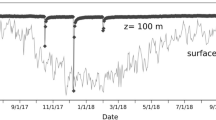Abstract
Temperature was monitored in two boreholes in Kamchatka (Russia) in years 2001–2003. Ten-min reading (sampling) interval was selected for the first half-year run followed by shorter (12 days) experiment with 5-s reading interval. A similar experiment was repeated later in the test borehole Sporilov (Prague, Czech Republic), where four temperature–time series were performed with reading intervals varying from 1 to 20 s. All temperature–time series (except the record from the bottom of the hole) displayed intermittent, non-periodic oscillations of temperature of up to several hundredths of degree with sharp gradients and large fluctuations over all observed time intervals. No such oscillation was detected at the bottom of the hole. The spectral analysis revealed a high level of stochasticity in the measured signal. Calculated spectra showed “band-pass” behavior without any definite peaks, which might characterize certain periodicity. Local growth of the second moment technique revealed the presence of at least two distinct temperature-forming processes. One of them can be related to heat transfer in the structurally and compositionally complex subsurface. The second process, which presents the bulk of the measured signal, probably reflects certain intra-hole convection. We hypothesized that the oscillatory regime of such convection is responsible for the stochastic nature of measured temperatures. Results of numerical modeling describing the fluctuation of water-cells in a vertical slot support the idea of thermally unstable water column in a hole, the instability of which produces a complex oscillation system. Model solutions and their discussion is presented in Part II of this work.











Similar content being viewed by others
References
Beck AE (1992) Inferring past climate change from subsurface temperature profiles: some problems and methods. Glob Planet Change 98:73–80
Bodri L, Cermak V, Yamano M (2004) Multifractal analysis of temperature time series from boreholes in Kamchatka. In: Proceedings of the 4th International Conference “Fractals and Dynamic Systems in Geoscience” TU München, May 2004, Selden, Tamm, Garching (Germany), ISBN 3-923561-24-5, pp 10–14
Bodri L, Cermak V (2005) Multifractal analysis of temperature time series: data from boreholes in Kamchatka. Fractals 13:299–310
Casdagli MC (1997) Recurrence plots revisited. Physica D 108:12–44
Cermak V, Safanda J, Kresl M , Dedecek P, Bodri L (2000) Recent climate warming: surface air temperature series and geothermal evidence. Studia Geophys et Geod 44:430–441
Cermak V, Safanda J, Yamano M, Nagao T, Taniguchi M, Okubo Y, Miyakoshi A, Gordeev E, Bodri L (2003) Climate Change in Kamchatka, Evidence from the Underground. In: Yamano M, Nagao T, Sweda T (eds) Geothermal/Dendrochronological Paleoclimate Reconstruction Across Eastern Margin of Eurasia. Proceedings volume 2002 International Matsuyama workshop, Ed Ehine Univ (Matsuyama, Japan), pp 100–109
Cermak V, Bodri L, Safanda J (2007) Precise temperature monitoring in boreholes: Evidence for oscillatory convection? Part II. Theory and interpretation. Int J Earth Sci, this volume
Davis A, Marshak A, Wiscombe W, Calahan R (1994) Multifractal characterizations of nonstationarity and intermittence in geophysical fields: observed, retrieved or simulated. J Geophys Res 99:8055–8072
Diment WH (1967) Thermal regime of a large diameter borehole: instability of the water column and comparison of air- and water-filled conditions. Geophysics 32:720–726
Eckmann J-P, Kamphorst S, Ruelle D (1987) Recurrence plots of dynamical systems. Europhys Lett 4:973–977
Gretener PE (1967) On the thermal instability of large diameter wells: an observational report. Geophysics 32:727–738
Haenel R, Rybach L, Stegena L (1988) Fundamentals of geothermics. In: Haenel R, Rybach L, Stegena L (eds) Handbook of terrestrial heat-flow density determination. Kluwer, Dordrecht, pp 9–57
Hastings HM, Sugihara G (1995) Fractals. A user’s guide for the natural sciences. Oxford University Press, Oxford, p 235
Howard LN (1964) Convection at high Rayleigh number.In: Görtler H (eds) Proceedings of 11th International Congress Applied Mechanics, München, Springer, pp 1109–1115
Iwanski JS, Bradley E (1998) Recurrence plots of experimental data: to embed or not to embed? Chaos 8:861–871
Kohl T (1998) Palaeoclimatic temperature signals: can they be washed out? Tectonophysics 291:225–234
Koster JN, Müller U (1982) Free convection in vertical gaps. J Fluid Mech 125:429–451
Koster JN, Müller U (1984) Oscillatory convection in vertical slots. J Fluid Mech 139:363–390
Koster JN, Ehrhard P, Müller U (1986) Nonsteady end effects in Hele-Shaw cells. Phys Rev Lett 56:1802–1804
Kukkonen IT, Safanda J (1996) Paleoclimate and structure; the most important factors controlling subsurface temperatures in crystalline rocks; a case history from Outokumpu, eastern Finland. Geophys J Int 126:101–112
Kvernvold O (1979) On the stability of non-linear convection in a Hele-Shaw cell. Int J Heat Mass Transf 22:395–400
Lovejoy S, Schertzer D, Silas P (1998) Diffusion in one-dimensional multifractal porous media. Water Resour Res 34:3283–3291
Marwan N, Thiel M, Nowaczyk NR (2002) Cross recurrence plot based synchronization of time series. Nonlinear Processes Geophys 9:325–331
Safanda J (1994) Effects of topography and climatic changes on the temperature in borehole GFU-1, Prague. Tectonophysics 239:187–197
Stulc P (1995) Return to thermal equilibrium of an intermittently drilled hole: theory and experiment. Tectonophysics 241:35–45
Trulla LL, Giuliani A, Zbilut JP, Webber CL Jr (1996) Recurrence quantification analysis of the logistic equation with transients. Phys Lett A223:255–260
Acknowledgments
The problems of the fluid convection and the corresponding temperature–time variations observed in boreholes were discussed with a number of colleagues and the authors benefited from their comments and personal opinions. The manuscript was read by two reviewers, Yuri Popov and Volker Rath, both offering valuable comments which were highly appreciated. Most of the reported studies were done under the co-operation programme between the Czech and Hungarian Academies of Sciences. The support of the Czech participation was partly provided by the Grant Agency of the Czech Republic (project GACR 205/03/0998) and the institutional expenses were funded from the research programmes Z3012916 and K3046108.
Author information
Authors and Affiliations
Corresponding author
Rights and permissions
About this article
Cite this article
Cermak, V., Safanda, J. & Bodri, L. Precise temperature monitoring in boreholes: evidence for oscillatory convection? Part 1: Experiments and field data. Int J Earth Sci (Geol Rundsch) 97, 365–373 (2008). https://doi.org/10.1007/s00531-007-0237-4
Received:
Accepted:
Published:
Issue Date:
DOI: https://doi.org/10.1007/s00531-007-0237-4




